
Fort Niagara, New York, courtesy of Wikipedia.
Old Fort Niagara, New York, also known as the Colonial Niagara Historic District, was a fortification built by New France to protect its interests in North America. As much or more fighting occurred here as at any other outpost during the colonial period of the United States. The Iroquois Confederacy, France, England, and the United States controlled the fort various times. Situated at the mouth of the Niagara River, it commanded the Great Lakes route between Lakes Erie and Ontario and protected the approaches to New York’s western frontier. The fort is on the river’s eastern bank of Lake Ontario. Youngstown, New York, later developed nearby.
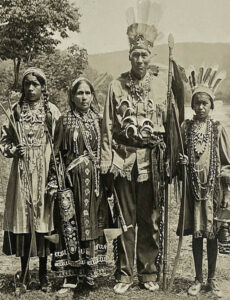
Seneca Indians
Seneca Indians occupied this area in the 17th Century, using it as a seasonal hunting and fishing camp. The first documented European visit to the future site of Fort Niagara occurred in 1669.
French explorer Rene-Robert Cavelier, Sieur de La Salle, built the first fortified structure, Fort Conti, in 1679. The post burned down before the end of the year.
In 1687, the Governor of New France, the Marquis de Denonville, built a new fort named Fort Denonville as part of their campaign against the Seneca. He posted 100 men as a garrison under the command of Captain Pierre de Troyes, Chevalier de Troyes. The winter weather and disease were severe, and all but 12 died of hunger and disease by the time a relief force returned from Montreal. Father Pierre Millet, a French Jesuit missionary to the Iroquois people, accompanied the French column sent to the relief of the dozen survivors. In 1688, Father Pierre Millet erected a large wooden cross at the site. That year, the government decided to abandon the post in September and had the stockade pulled down.
In 1726-27, French engineer Gaspard-Joseph Chaussegros de Léry erected the notable Stone House, or “Castle,” a fort built to resemble a French provincial chateau to delude the Indians.
During King George’s War, the French strengthened Fort Niagara and constructed a Bake House in 1747.
In 1755, the French expanded the fort to its present size in response to the armed confrontation between French and British colonial interests as part of the French and Indian War. The Stone House and temporary buildings were converted into an elaborate stronghold with earthworks, moats, magazines, and gun emplacements. Much of this later improvement remains.
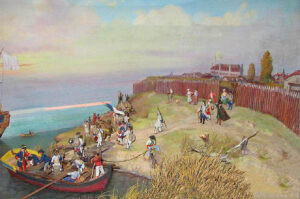
Fort Niagara, New York, 1726.
Beginning in 1756, the main entrance to Fort Niagara was established at the southern bastion on the side of the Niagara River. The French named it the Gate of the Five Nations in honor of the Iroquois League. The following year, the French erected a large stone Powder Magazine.
Britain gained control of Fort Niagara after a 19-day siege in July 1759. Fort Niagara served as the Loyalist base in New York during the American Revolution for Colonel John Butler and his Butler’s Rangers, a Tory militia commanded by the British Army. Lieutenant Colonel William Stacy, a high-ranking officer of the Continental Army, was captured by Butler’s Rangers in their attack on Cherry Valley, New York. He was held captive at Fort Niagara during the summer of 1779. At that time, the fort was notorious for drinking, brawling, whoring, and cheating. Crude taverns, stores, and bordellos sprouted on “the Bottom,” the riverside flat below the fort. The British held the post throughout the war but were forced by the Jay Treaty to yield it to the United States in 1796.
Between 1763 and 1766, Native Americans rose up in Pontiac’s War. At that time, Fort Niagara was critical in supplying Detroit, Michigan. The British forces were defeated in September 1763 at Devil’s Hole, 11 miles south of Fort Niagara.
Fort Niagara was recaptured by the British in 1813. At the end of the War of 1812, it was ceded to the United States again in 1815. T
During the War of 1812, the fort’s guns sank the Provincial Marine schooner Seneca on November 21, 1812. British forces captured the fort on the night of December 19, 1813, in retaliation for the Americans’ burning of Niagara, formerly called Newark, nine days earlier. This was Fort Niagara’s last armed conflict, and afterward, it served as a peaceful border post.
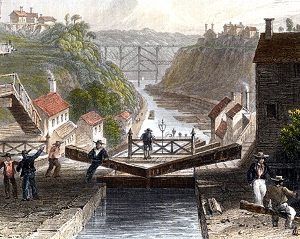
Erie Canal, New York
With the completion of the Erie Canal in 1825, Fort Niagara’s strategic value diminished.
In response to the Canadian Rebellion of 1837, the U.S. made extensive alterations to Fort Niagara’s buildings and fortifications from 1839 to 1843. A new stone wall and hot shot battery were constructed on the riverside of the fort.
In the post-Civil War era, the “New Fort Niagara” was built outside the fort’s original walls. The military abandoned masonry forts in this era, having found that masonry fared poorly under bombardment.
The new Fort Niagara had a 1,000-yard rifle range, rail lines, and access to the industrial areas of Niagara Falls and Buffalo, New York.
Fort Niagara trained troops for the Spanish-American War.
As the United States prepared for entry into World War I in June 1917, the post began an officer training school.
A formal operating license between Old Fort Niagara Association and the U.S. War Department in 1931 established the rights of the non-profit group to preserve and operate the fort.
During World War II, the fort was an induction center before it became a prisoner-of-war camp for 1,200 German soldiers captured in the North African Campaign. After the war, the fort provided temporary housing for returning veterans.
Fort Niagara was a barracks and training station for American soldiers throughout both World Wars.
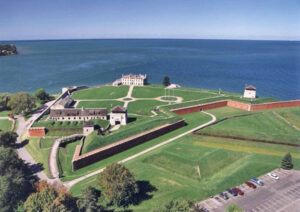
Fort Niagara, New York Aerial.
During the Korean War, the fort was a headquarters for anti-aircraft artillery and later Nike missiles. After uniting the Niagara Falls and Buffalo Defense Areas, the Army Air Defense Command Post moved to Lockport Air Force Station in Cambria, New York.
In 1960, the fort was among the first sites designated a National Historic Landmark by the Department of Interior’s National Park Service.
Formations directing U.S. defenses included the 2nd Artillery Group (Air Defense), which had its headquarters at Fort Niagara from March 1958 to December 1961.
The U.S. Army officially deactivated Fort Niagara in 1963. The 4th Air Defense Artillery Regiment moved to the Seattle Defense Area.
The Colonial Niagara Historic District was placed on the National Register of Historic Places on October 15, 1966. It is a major contributing element to the Niagara Falls National Heritage Area. Fort Niagara is considered one of the longest continuously run military bases within the boundaries of the United States, from French control in 1726 to the present day.
A military presence on the site continues with the United States Coast Guard operating at “The Bottoms.”
The fort is one of the best restored and preserved fortresses in America. Restored features include the famous “Stone House,” a moat, a drawbridge, a blockhouse, earthen ramparts, parade grounds, and a cross symbolic of one planted on the site in 1688 by Father Pierre Millet. Other 18th-century buildings include an above-ground powder magazine, a Bake House, a Provisions Storehouse, and two stone redoubts.
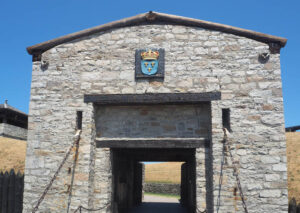
Fort Niagara, New York Main Gate, courtesy Wikipedia.
The renovated Fort Niagara now serves as Fort Niagara State Park and Museum. It is often the site of historical reenactments of 18th-century battles that took place here. It is also a venue for period dances, fundraisers, and other special events. Fort Niagara is also designated as a State Historic Site, known as Old Fort Niagara State Historic Site. The fort welcomes over 200,000 visitors a year.
Hauntings:
In addition to Fort Niagara’s 300+ years of history, the old fortress is allegedly haunted. Many who have visited report unexplained shadows, slamming doors, dark floating mists, eerie orbs, and shadowy figures in photographs. Many interpret these paranormal events as caused by the fort’s blood-stained history.
Among the best-known tales is of a headless ghost who reputedly haunts Old Fort Niagara’s French Castle. Legends say that this is the ghost of a French officer who was killed in a sword duel with another soldier.
This military officer was stationed at the fort during a large party at the 1726 French Castle. Many young women from the Seneca tribe were in attendance, and the officer was immediately smitten with one of them. However, another interested suitor continually thwarted the officer’s advances. What began as an argument between the two men soon became a sword fight. During the scuffle, the officer fell down a stone staircase; his adversary followed and stabbed him to death. Afterward, he decapitated the officer, dumped his head in Lake Ontario, and stuffed the headless body down the castle’s well.
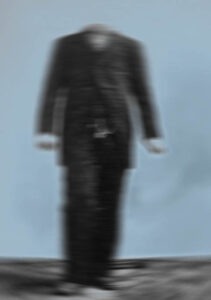
Headless Ghost
Now, the headless French officer’s ghost is said to wander about the property, searching for his head. Sightings report that his headless spirit had been seen climbing out of the old well on full moon nights and wandering about the property. Others have captured the shadowy headless figure in photographs.
Another supernatural legend of a mischievous hobgoblin also shrouds Fort Niagara. This story dates to 1804 when a young piper named John Carroll was punished for drunkenness with a night in solitary confinement. In the black hole dug into the floor of one of the buildings, he said he was visited by this mystical entity, described as a demon, who demanded that he write a song or a hymn when he left confinement. The soldier complied.
Several years later, in 1812, a soldier was on guard duty at night when he allegedly saw something strange in the cemetery during a lightning strike. Quickly, he fired his rifle at the object before running away and knocking himself out when he ran into a barricade. The sighting has no further details, but the hobgoblin legend persists today.
The ghostly legends surrounding Fort Niagara have attracted national attention for years and have been featured on several paranormal investigation television shows, including on Discovery Channel’s Ghost Lab and Syfy’s Ghost Hunters.
The fort museum operators offer special tours each year that highlight its mysterious and haunted history, including scenes of violent death, sickness, and starvation. During the tour, various animated “ghosts and ghouls” wander the dark corridors of the French Castle.
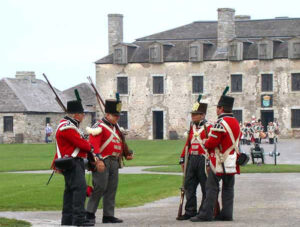
Re-enactors at Fort Niagara, New York, courtesy of Wikipedia.
More Information:
Old Fort Niagara
102 Morrow Plaza,
P.O. Box 169 Youngstown, New York, 14174-0169
716.745.7611
©Kathy Alexander/Legends of America, March 2024.
Also See:
Forts Across the United States
Forts & Presidios Photo Gallery
Soldiers & Officers in American History
Sources:
Country WYRK
Haunted U.S.
Lite 98.7
National Park Service – Explorers
National Park Service – Patriots
Niagara Frontier Publications
Old Fort Niagara
Wikipedia
